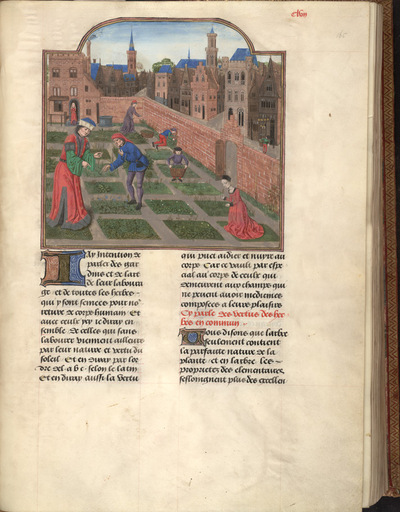Javascript must be enabled to continue!
Le Liure de Rustican des Prouffiz Ruraulx
View through Europeana Collections
This illustration of a herb garden comes from a
late-15th-century manuscript copy of ‘Le Luire de Rustican de
prouffiz ruraulx’, a treatise on agriculture. The original text was
written in Italy in Latin. It was one of the many works translated
into French by command of King Charles V during the 13th
century.Herb gardens generally followed the arrangement pioneered
in monasteries. A 9th-century plan of an ideal monastery, drawn up
at St Gall in Switzerland, still survives. It shows four gardens,
one being the herbularius laid out close to the infirmary.Bede, the
famous Anglo-Saxon monk, gives advise on monastic kitchen gardens
in his 8th-century writings. Abbot Strabo of Riechenau listed the
plants he grew at his abbey in the first half of the 9th century.
They included sage, fennel, rue, lovage and chervil.The timing of
planting and harvesting herbs often had symbolic as well as
practical significance. One author in the 14th century recommended
sowing parsley on St John’s Eve in June and cutting it only in the
evening or early morning.
Title: Le Liure de Rustican des Prouffiz Ruraulx
Description:
This illustration of a herb garden comes from a
late-15th-century manuscript copy of ‘Le Luire de Rustican de
prouffiz ruraulx’, a treatise on agriculture.
The original text was
written in Italy in Latin.
It was one of the many works translated
into French by command of King Charles V during the 13th
century.
Herb gardens generally followed the arrangement pioneered
in monasteries.
A 9th-century plan of an ideal monastery, drawn up
at St Gall in Switzerland, still survives.
It shows four gardens,
one being the herbularius laid out close to the infirmary.
Bede, the
famous Anglo-Saxon monk, gives advise on monastic kitchen gardens
in his 8th-century writings.
Abbot Strabo of Riechenau listed the
plants he grew at his abbey in the first half of the 9th century.
They included sage, fennel, rue, lovage and chervil.
The timing of
planting and harvesting herbs often had symbolic as well as
practical significance.
One author in the 14th century recommended
sowing parsley on St John’s Eve in June and cutting it only in the
evening or early morning.
Related Results
Sonnets et Eaux-Fortes, Paris (Alphonse Lemerre), 1869
Sonnets et Eaux-Fortes, Paris (Alphonse Lemerre), 1869
Series of 42 etchings on laid paper...
portrait from "Histoire de la Révolution Française dans le département des Pyrénées-Orientales, d'après les documents inédits des archives départmentales, communales et particulières, 1789-1800".
portrait from "Histoire de la Révolution Française dans le département des Pyrénées-Orientales, d'après les documents inédits des archives départmentales, communales et particulières, 1789-1800".
This image has been taken from scan 000030 from volume 03 of "Histoire de la Révolution Française dans le département des Pyrénées-Orientales, d'après les documents inédits ...
Double Rainbow from "Materials Lab"
Double Rainbow from "Materials Lab"
Box 6, (Not) Reading Double Rainbow Colors, from "Materials Lab"
Archival materials include:
-- 1 installation shot of (Not) Reading Double Rainbow Colors, 2011
-- 1 inkjet ...
Vignette, page 130 (Chapter XXXVI, Volume II), from Les Incas, ou la Destruction de l'empire du Pèrou; Par M. Marmontel, Historiographe de France, l'un des Quarante de l'Acadèmie Françoise. "Accordez à tous la tolérance civile, non en approuvant tout comm
Vignette, page 130 (Chapter XXXVI, Volume II), from Les Incas, ou la Destruction de l'empire du Pèrou; Par M. Marmontel, Historiographe de France, l'un des Quarante de l'Acadèmie Françoise. "Accordez à tous la tolérance civile, non en approuvant tout comm
Etching and engraving; third state of three (Bocher), Les Incas ou la Destruction de l'empire du Pèrou; Par M. Marmontel Historiographe de France l'un des Quarante de l'Acadèmie...




